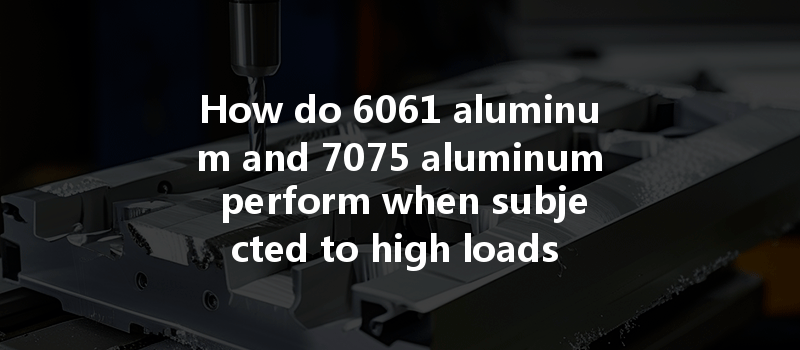Did you know that aluminum is one of the most commonly used materials for manufacturing aircraft, automotive parts, and consumer goods? In fact, its lightweight yet robust nature makes it a top choice for industries demanding high strength-to-weight ratios. Among the various aluminum alloys, 6061 and 7075 are notable contenders. But have you ever wondered how these two alloys perform under high loads?
This comprehensive blog will dive deep into the differences between 6061 and 7075 aluminum, especially when subjected to high loads in CNC (Computer Numerical Control) machining processes. We will explore their physical and mechanical properties, their applications in various industries, performance metrics under load, and insights into selecting the right alloy for your next machining project.
The Fundamentals of Aluminum Alloys
Aluminum Alloys Overview
Aluminum alloys are categorized into two main groups: wrought and cast. The 6061 and 7075 alloys fall into the wrought category, meaning they’re processed mechanically to enhance characteristics such as strength and resistance to corrosion. These alloys are designated by a four-digit numerical system, where the first digit indicates the principal alloying element.
Mechanical Properties at a Glance
To fully understand how both aluminum alloys perform under high loads, let’s examine their key mechanical properties:
| Property | 6061 Aluminum | 7075 Aluminum |
|————————-|—————|—————|
| Yield Strength | ~240 MPa | ~570 MPa |
| Ultimate Tensile Strength| ~310 MPa | ~700 MPa |
| Elongation at Break | ~12% | ~8% |
| Hardness (Brinell) | ~95 HB | ~150 HB |
| Fatigue Strength | Good | Excellent |
| Corrosion Resistance | Excellent | Good |
Table of Mechanical Properties
Applications of 6061 and 7075 Aluminum
Understanding the applications of these alloys helps contextualize their performance under high loads.
How Do 6061 and 7075 Perform Under High Loads?
When subjected to tensile loads, 7075 aluminum significantly outperforms
Real-World Example: Aerospace Components
In the aerospace industry, components made from 7075 aluminum are common in aircraft wings and frames due to their lightweight nature and high load-bearing capacity. In contrast, 6061 may be used in non-critical structural applications, such as support brackets or fairings, where the loads are comparatively lighter.

Fatigue resistance is crucial in applications exposed to cyclic loading. While both materials possess fatigue strength, 7075 aluminum is recognized for its superior performance under dynamic loads. Applications that experience repeated stress, such as landing gears or fuselage braces, benefit immensely from the durability of
3. Environmental Considerations
Another crucial aspect when evaluating performance under load is corrosion resistance. Although 7075 aluminum excels in strength, it is more susceptible to corrosion than
Machining Considerations
When it comes to CNC machining, both alloys present unique challenges and advantages. Understanding how to effectively machine these materials can significantly impact the final product’s integrity and longevity.
Machining 6061 Aluminum
Machining 7075 Aluminum
Best Practices for Load Performance
To maximize the performance of either material under high loads, consider the following best practices:
Testing the Load Performance of Aluminum Alloys
Understanding load performance requires thorough testing. Companies should consider running tensile and fatigue tests on prototypes made from both alloys. These tests can provide valuable insights into how each alloy will behave in real-world applications.
In summary, while both 6061 and 7075 aluminum alloys have unique strengths and weaknesses, understanding their load performance can significantly impact your machining processes and product outcomes. With 7075 being the preferred choice for high-stress applications due to its superior strength and fatigue resistance, 6061 still holds value in applications requiring good corrosion resistance and workability.
The key takeaway is to meticulously evaluate your specific needs, taking into account mechanical properties, application requirements, and machining capabilities. A well-informed choice can enhance not just performance, but longevity and cost-efficiency as well.
Final Thoughts
Choosing between 6061 and 7075 aluminum is no trivial matter. An informed decision can lead to improved product reliability and performance, especially in demanding applications. As industries continue to evolve, so too will the technology and methods used to machine these essential materials. Whether it’s for aerospace, automotive, or other applications, understanding the nuanced differences between these aluminum alloys will arm you with the knowledge to make the best choices for your projects.
With this comprehension, you can ensure that you’re not only achieving optimal performance under load but also promoting sustainability and cost-effectiveness within your operations. So, the next time you embark on a CNC machining project, consider the nuances we’ve discussed—your choice of materials could very well determine the success of your endeavors!



